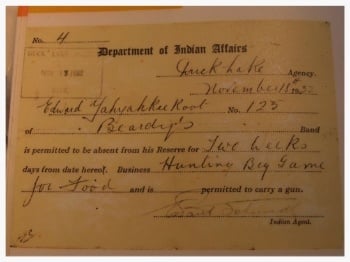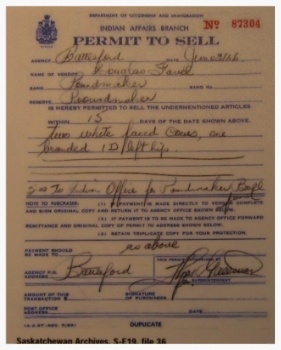"The great aim of our legislation has been to do away with the tribal system and assimilate the Indian people in all respects with the other inhabitants of the Dominion as speedily as they are fit to change.” - John A Macdonald, 1887
- Since publication in June 2015, this article has had 303,000+ views. - February 2020
Many laws affecting Aboriginal Peoples were combined in 1876 to become the Indian Act. The Act gave Canada a coordinated approach to Indian policy rather than the pre-Confederation piece-meal approach.
 Here is a permission slip that would have be required to leave the reserve. Although specifically not a law or regulation under the Indian Act, the Indian Act gave power to the federal government and its representatives, like the Indian Agent, to implement and enforce policies such as needing a pass to leave the reserve. It certainly is something that not many people would have known about the Indian Act.
Here is a permission slip that would have be required to leave the reserve. Although specifically not a law or regulation under the Indian Act, the Indian Act gave power to the federal government and its representatives, like the Indian Agent, to implement and enforce policies such as needing a pass to leave the reserve. It certainly is something that not many people would have known about the Indian Act.
The Indian agent, acting under the authority of the Indian Act, played a key role in the distribution of land, replacing traditional names for "easier" identification and altering traditional and hereditary forms of government, among other actions and restrictions.
The Indian Act has been a lightning rod for criticism and controversy over the years, widely attacked by First Nations people and communities for its regressive and paternalistic excesses. For example, Indians living on reserves don’t own the land they live on; assets on reserve are not subject to seizure under legal process making it extremely difficult to borrow money to purchase assets; and, matrimonial property laws don’t apply to assets on reserve. On the other hand, it has also been widely attacked by non-Aboriginal Peoples and politicians as being too paternalistic and creating an unjust system with excessive costs that are considered uneconomical.
Here are some of the restrictions and impacts imposed on First Nations (some have since been removed in revisions of the Act).
The Indian Act:
- denied women status;
- introduced residential schools;
- created reserves;
- renamed individuals with European names
- restricted First Nations from leaving reserve without permission from Indian Agent - see picture above (update: 18/04/16 - the pass system was a policy endorsed by the government; it was never an Order In Council or Regulation but was definitely designed to keep First Nations on the reserve)
- enforced enfranchisement of any First Nation admitted to university [1];
- could expropriate portions of reserves for roads, railways and other public works, as well as to move an entire reserve away from a municipality if it was deemed expedient;
- could lease out uncultivated reserve lands to non-First Nations if the new leaseholder would use it for farming or pasture;
- forbade First Nations from forming political organizations;
- prohibited anyone, First Nation or non-First Nation, from soliciting funds for First Nation legal claims without special license from the Superintendent General. (this 1927 amendment granted the government control over the ability of First Nations to pursue land claims) [2];
- prohibited the sale of alcohol to First Nations;
- prohibited sale of ammunition to First Nations;
- prohibited pool hall owners from allowing First Nations entrance;
- imposed the "band council" system;
 forbade First Nations from speaking their native language;
forbade First Nations from speaking their native language;- forbade First Nations from practicing their traditional religion;
- forbade western First Nations from appearing in any public dance, show, exhibition, stampede or pageant wearing traditional regalia [3];
- declared potlatch and other cultural ceremonies illegal [4];
- denied First Nations the right to vote;
- created permit system to control First Nations ability to sell products from farms;
- is a piece of legislation created under the British rule for the purpose of subjugating one race - Aboriginal people.
Major amendments were made to the Act in 1951 and 1985. In the 1951 amendments, the banning of dances and ceremonies, and the pursuit of claims against the government were removed. In the 1985, Bill C-31C-31 was introduced. For more on this Bill, please see: "Indian Act and Women's Status - Discrimination via Bill C31 and Bill C3".
The Indian Act imposed great personal and cultural tragedy on First Nations, many of which continue to affect communities, families and individuals today.
Chief Dr. Robert Joseph, talk about Anti-Potlatching here. https://youtu.be/ge_pM9k1CPs
[1] Section 99 (1) of the Indian Act of 1880
[2] Section 141 of the Indian Act of 1927
[3] Section 140 of the Indian Act of 1927
[4] Section 3 of the Indian Act of 1880
Thanks for reading this blog article. Here are some of the references we used:
CHAP. 18. - An Act to amend and consolidate the laws respecting Indians.
No comments:
Post a Comment